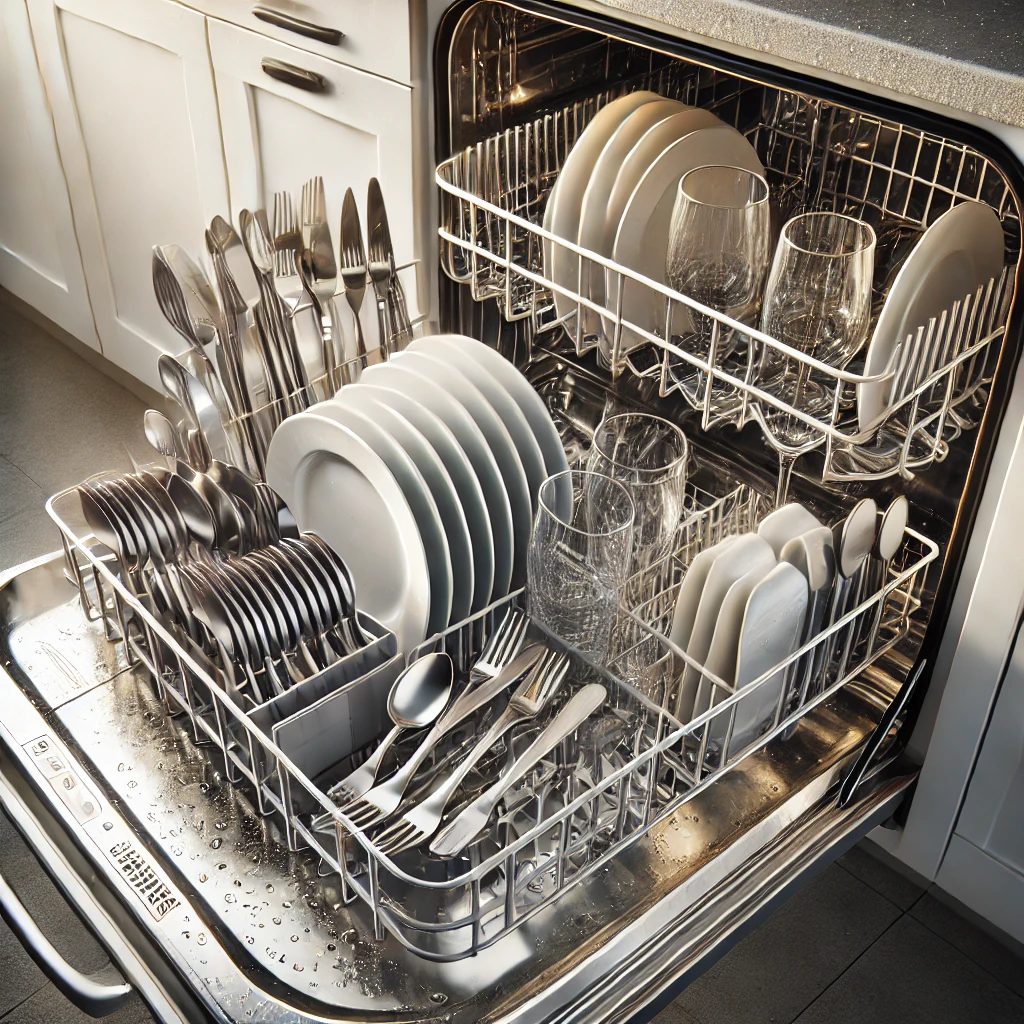
How to Clean Your Dishwasher Properly: A Step-by-Step Guide
Your dishwasher works hard to keep your dishes sparkling clean, but it also needs regular maintenance to perform at its best. Over time, food particles, grease, and soap scum can build up, leading to unpleasant odours, reduced efficiency, and even mechanical problems. To keep your dishwasher running smoothly, it’s essential to clean it properly. Here’s a step-by-step guide to cleaning your dishwasher thoroughly.
1. Clean the Filter
The filter in your dishwasher catches food particles and debris to prevent them from clogging the drain. Over time, these particles can build up and cause unpleasant odours or blockages, reducing your dishwasher’s performance.
Steps:
- Locate the Filter: Most dishwashers have a filter at the bottom, near the spray arm. Consult your dishwasher’s manual if you’re unsure where it is.
- Remove the Filter: Carefully remove the filter by twisting or pulling it out, depending on your model.
- Rinse the Filter: Rinse the filter under warm running water to remove debris. Use a soft brush or sponge to scrub away any stubborn residue or grease.
- Reinstall the Filter: After cleaning, place the filter back into its position securely.
How Often to Clean: Ideally, clean the filter once a week or at least once a month, depending on how frequently you use your dishwasher.
2. Wipe Down the Door and Gasket
The door and gasket (the rubber seal around the door) can accumulate grime, soap scum, and mildew, leading to bad smells or a less effective seal. Cleaning these areas will help prevent leaks and keep your dishwasher smelling fresh.
Steps:
- Wipe with a Damp Cloth: Use a damp cloth or sponge with warm, soapy water to wipe down the door, paying attention to the edges and crevices.
- Clean the Gasket: Gently clean the rubber gasket with a cloth soaked in warm water. Make sure to wipe around the edges to remove any trapped food particles or mildew.
How Often to Clean: Wipe down the door and gasket every couple of weeks to prevent build-up.
3. Clean the Spray Arms
The spray arms are responsible for distributing water evenly during the wash cycle. If they become clogged with food particles or mineral deposits, they may not spray effectively, leading to poor cleaning results.
Steps:
- Remove the Spray Arms: Most dishwashers have removable spray arms. Check your manual for instructions on how to remove them.
- Clean the Nozzles: Use a toothpick or a small brush to clear any debris or food particles from the nozzles.
- Rinse and Reinstall: Rinse the spray arms under warm water and reinstall them.
How Often to Clean: Clean the spray arms every few months or whenever you notice reduced cleaning efficiency.
4. Run a Cleaning Cycle with Vinegar
Vinegar is a natural cleaner that helps break down grease, soap scum, and mineral deposits inside your dishwasher. Running a cleaning cycle with vinegar is a simple way to deep clean your machine.
Steps:
- Fill a Dishwasher-Safe Bowl with Vinegar: Pour about 1 cup of white vinegar into a dishwasher-safe bowl or cup.
- Place the Bowl on the Top Rack: Place the bowl or cup filled with vinegar on the top rack of the empty dishwasher.
- Run a Hot Cycle: Run the dishwasher on the hottest cycle available. The vinegar will help dissolve grime and remove odours.
How Often to Clean: Run a vinegar cleaning cycle once a month to maintain a clean and fresh-smelling dishwasher.
5. Use Baking Soda for Extra Freshness
For an extra boost of cleaning power, you can use baking soda after running the vinegar cycle. Baking soda is great for removing stains and deodorising your dishwasher.
Steps:
- Sprinkle Baking Soda: After the vinegar cycle, sprinkle about 1 cup of baking soda across the bottom of the dishwasher.
- Run a Short Cycle: Run a short hot water cycle. The baking soda will scrub away any remaining residue and help neutralise any lingering odours.
How Often to Clean: Use baking soda every 1-2 months or whenever your dishwasher needs extra deodorising.
6. Check and Clean the Drain
A clogged or dirty drain can lead to standing water and unpleasant smells. Keeping the drain clear ensures that your dishwasher drains properly after each cycle.
Steps:
- Inspect the Drain: After removing the bottom rack, check the drain area for any debris, food particles, or foreign objects.
- Clean the Drain: Use a paper towel or a brush to remove any visible debris. If your drain is clogged, consider using a mild cleaning solution or consult your manual for further cleaning instructions.
How Often to Clean: Inspect and clean the drain every few months to prevent clogs.
7. Wipe the Exterior
While it’s important to focus on the inside of your dishwasher, don’t forget about the exterior. Fingerprints, smudges, and spills can make your appliance look dirty and worn.
Steps:
- Use a Microfibre Cloth: Wipe the exterior with a microfibre cloth or sponge soaked in warm, soapy water. Avoid using abrasive cleaners that can scratch the surface.
- Polish Stainless Steel: If your dishwasher has a stainless steel finish, use a stainless steel cleaner or vinegar and water solution to polish and remove smudges.
How Often to Clean: Wipe down the exterior as needed, ideally once a week.
Conclusion
Regular cleaning and maintenance of your dishwasher are essential to keeping it running efficiently and odour-free. By following these simple steps—cleaning the filter, wiping down the door and gasket, maintaining the spray arms, and running a cleaning cycle with vinegar and baking soda—you’ll ensure your dishwasher continues to provide spotless results. Make these steps part of your routine, and your dishwasher will thank you with years of reliable service.

